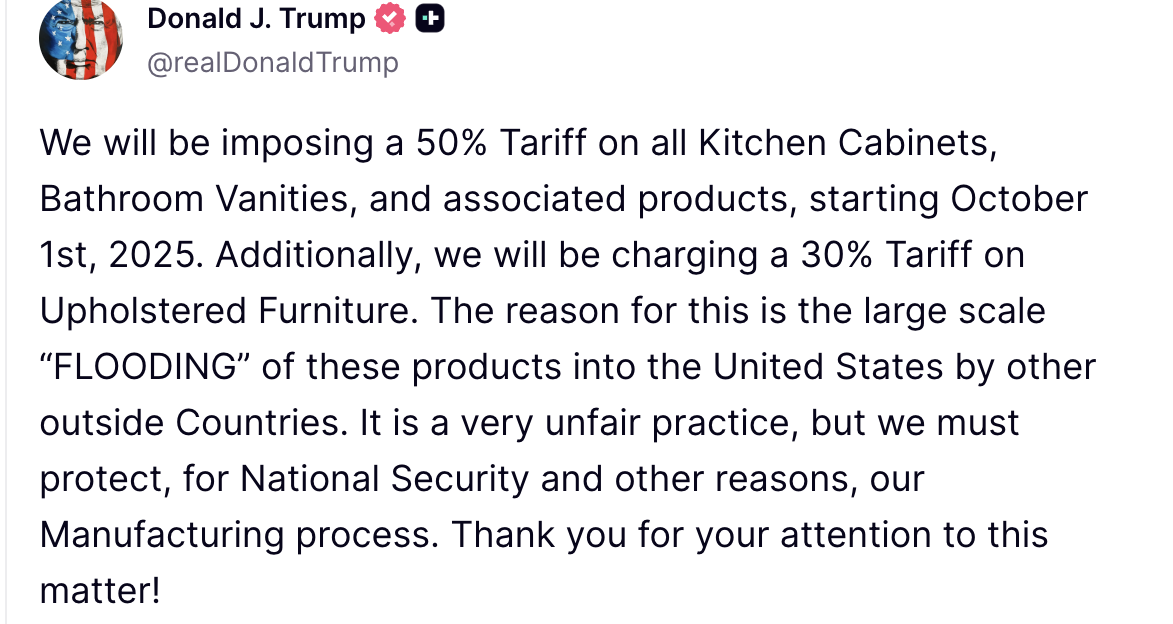
In late September 2025 the U.S. announced new tariff measures on wood products, including kitchen cabinets, introduced under a Section 232 national security action. The initial tariff took effect October 14 (25% on cabinets and higher rates for related products) with the possibility of further increases to 50% on January 1, 2026 unless agreements or adjustments are made. These decisions are already reshaping the cross-border cabinetry market and will affect pricing, timelines, and procurement choices on both sides of the border. Reuters+1
In late September 2025 the U.S. announced new tariff measures on wood products, including kitchen cabinets, introduced under a Section 232 national security action. The initial tariff took effect October 14 (25% on cabinets and higher rates for related products) with the possibility of further increases to 50% on January 1, 2026 unless agreements or adjustments are made. These decisions are already reshaping the cross-border cabinetry market and will affect pricing, timelines, and procurement choices on both sides of the border. Reuters+1
What this means (clearly):
For Canadian manufacturers: Exports to the U.S. (a major market) face a steep new cost barrier that may reduce orders, force pricing shifts, or change production planning. Canadian Kitchen Cabinet Association
For U.S. dealers & builders: The tariff is likely to increase material costs, potentially slowing projects or shifting sourcing decisions. Industry groups warn it will raise construction and renovation costs. National Association of Home Builders
For homeowners: Some renovation and build projects may become more expensive or delayed as the market adjusts. Reuters
Why we’re concerned — and why this isn’t a political soundbite:
Our focus is practical: fair trade and stable supply chains are in everyone’s best interest. While governments debate policy, manufacturers and dealers are left to manage procurement, pricing and schedules. Large tariffs that pivot suddenly create uncertainty and can hurt local jobs in both countries. We believe in defending Canadian manufacturing while urging trade policies that avoid unnecessary harm to builders and consumers. Woodworking Network+1
What Westwood is doing now:
Communicating with U.S. and Canadian dealer partners about lead times and pricing.
Reviewing inventory, logistics and production scheduling to limit disruption.
Working with CKCA and industry partners to pursue trade remedies and advocacy.
Providing transparent pricing and quote validity windows to help builders plan.
How dealers and builders can work with us:
Contact your Westwood rep for updated lead times and alternative sourcing options.
For quotes, ask for clear expiry dates and contingency options if tariffs change.
Consider staged procurement or increased communication with clients about potential cost changes.
We hope policymakers will pursue negotiated solutions rather than prolonged tariffs that risk higher costs for businesses and households. In the meantime, Westwood is committed to supporting dealers and clients through careful planning and open communication. For media inquiries or dealer support, contact Richelle Tarr, Director, Business Operations at Westwood Cabinetry - rishellet@westwoodcabinetry.com.
As of October 14, 2025, the United States has imposed a 25% tariff on imported kitchen cabinets as part of a broader Section 232 trade action. Unless an agreement or adjustment is reached, those tariffs are scheduled to rise to 50% on January 1, 2026. These measures apply to Canadian cabinetry exported into the U.S. market.
The impact is felt by multiple groups:
Canadian cabinet manufacturers, who face steep cost barriers when exporting to the U.S.
U.S. dealers and builders, who rely on Canadian cabinetry for affordable, high-quality projects.
Homeowners, who may see higher costs or longer lead times on renovations and new builds.
Yes, potentially. With tariffs adding as much as 25–50% to the cost of imported cabinetry, U.S. builders may pass along those increases to homeowners. This could affect project budgets, timelines, and choices around cabinetry lines. In Canada, the effect may be less direct, but Canadian companies exporting to the U.S. may experience reduced orders or price pressures.
Canadian manufacturers support fair and competitive trade. Tariffs of this scale create artificial barriers that disrupt long-standing supply chains, raise costs for U.S. builders and homeowners, and threaten Canadian jobs. Both countries benefit when the cabinetry trade remains open, competitive, and predictable.
Westwood Cabinetry is actively:
Communicating with dealer partners about pricing and lead times.
Reviewing production and inventory strategies to reduce disruption.
Working with the Canadian Kitchen Cabinet Association (CKCA) and other industry partners to advocate for fair trade practices.
Keeping clients informed with transparent quotes and contingency planning.